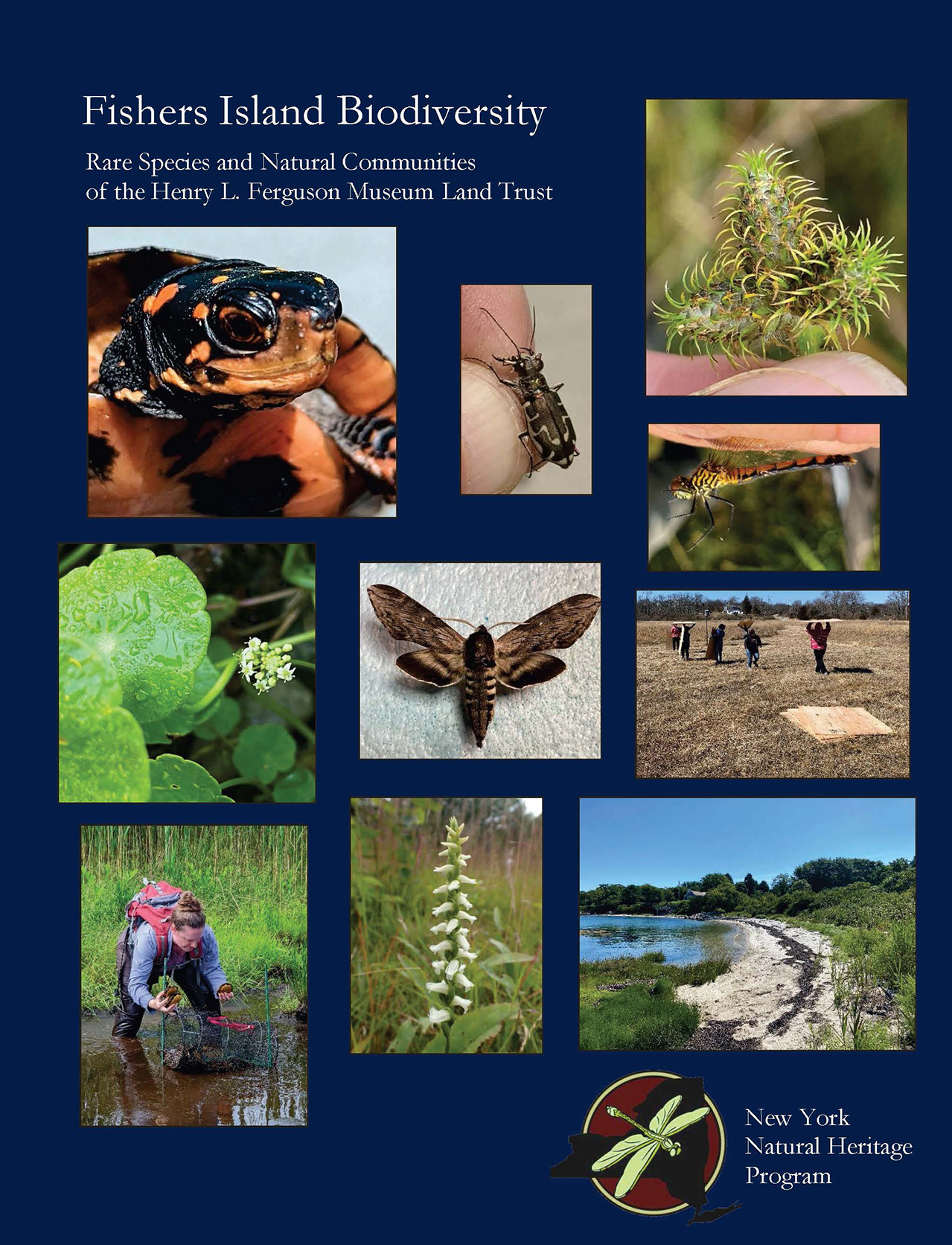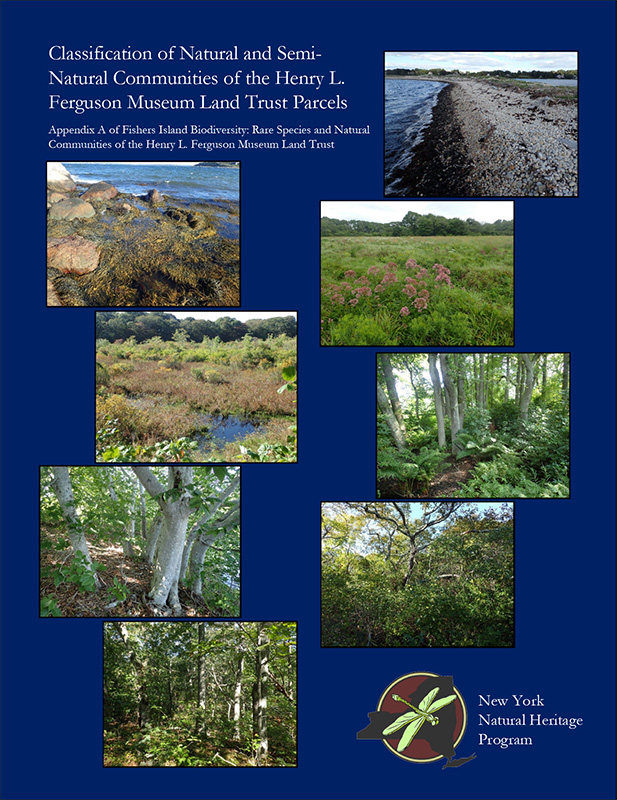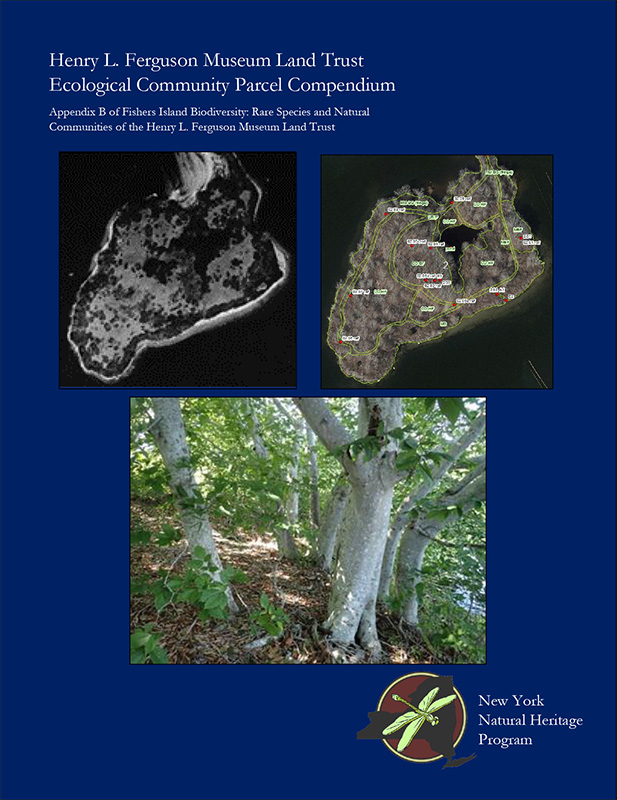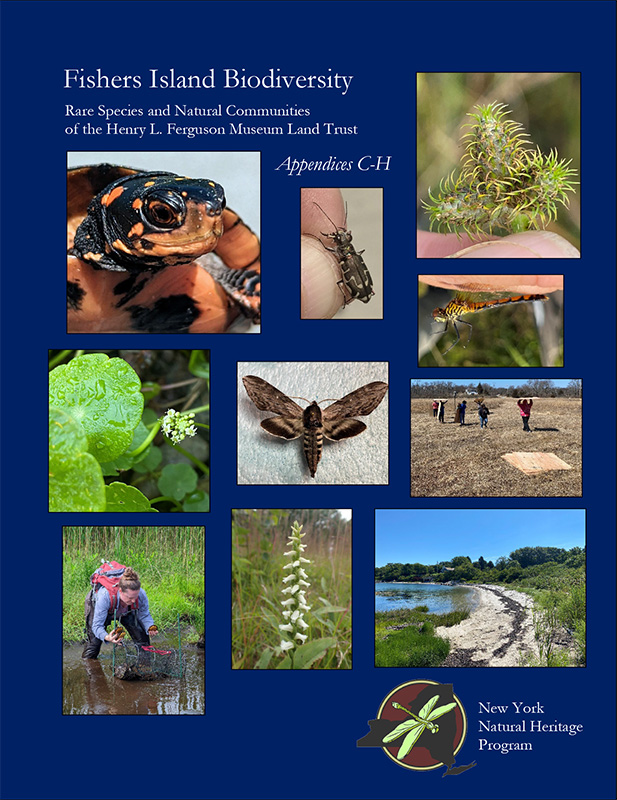Fishers Island Biodiversity:
Rare Species and Natural Communities of the Henry L. Ferguson Museum Land Trust
New York Natural Heritage Program
July 2023
The Henry L. Ferguson Museum contracted with the New York Natural Heritage Program (NYNHP) in early 2020 to conduct a two-year inventory of rare plants and animals and map the natural communities of its Land Trust parcels on Fishers Island. The survey took place between May 2021 and October 2022. In this report, NYNHP scientists present the results of their inventory and provide management and restoration recommendations.
They conducted surveys for rare plants, significant natural communities, and a variety of animal groups including small mammals, birds, turtles, snakes, salamanders, frogs, marine fish, marine invertebrates, and several groups of insects. They also mapped the ecological communities of the Land Trust parcels. Follow-up surveys of recently acquired parcels were conducted and the results will be posted when received from NYNHP.
The following NYNHP scientists are the primary authors of this report:
Matthew D. Schlesinger, Chief Zoologist
Richard M. Ring, Chief Botanist
Gregory J. Edinger, Chief Ecologist
Ashley M. Ballou, Zoologist
Katie G. Hietala-Henschell, Zoologist
Meaghan A. McCormack, Marine Zoologist
John P. Vanek, Zoologist
Erin L. White, Zoologist and Project Coordinator
Stephen M. Young, Former Chief Botanist
Cover photos (left to right, top to bottom): Spotted Turtle, Hairy-necked Tiger Beetle, Dwarf Umbrella Sedge, Seaside Dragonlet, Manyflower Marsh-pennywort, Northern Apple Sphinx, students carrying coverboards, Ashley Ballou with hands full after checking a turtle trap, Yellow ladies’ tresses, Chocomount Cove.
The following is the Acknowledgments section of the NYNHP Fishers Island Biodiversity report:
Acknowledgments
Elizabeth McCance, Pierce Rafferty, Terry McNamara, Jack Schneider, and members of the board of the Henry L. Ferguson Museum were enthusiastic partners and consummate hosts. Hugh McGuinness identified all moth specimens, gave context to the findings, and offered valuable feedback on sampling methods. Portions of his report to NYNHP are excerpted here. Katie Beeles, Julie Hart, Daniel Schlaepfer, Carmen Greenwood, Jim Hardin, Eliza Schlesinger, and Flora Schlesinger assisted with field work. Adam Murray and his students cut coverboards and helped with deployment, dug holes, and impressed us with their maturity and knowledge. Lydia Doucette, in particular, helped above and beyond with moth trapping. Ellizabeth McCance, Bryan Danforth and Marina Caillaud, Lucinda Herrick and Kathrin Leuchtenburg, Sarah and Steve Malinowski, Ellen and Harry Parker, and Vicki and Pierce Rafferty provided the best field housing ever. Donors to the Henry L. Ferguson Museum supported this project financially. Kevin Jennings from NYS DEC shared bat call files, Adam Mitchell shared moth data, and Murray Fisher showed us some of his discoveries and inspired others to contribute to iNaturalist. At NYNHP, DJ Evans and Fiona McKinney gave administrative and moral support, Emily Cheadle made maps, Tim Howard compiled FQA data, and Max Henschell compiled LCA data. Max, Dave Kramer, and Leah Akins watched the kids and various people took care of our pets.
Suggested citation: Schlesinger, M. D., G. J. Edinger, R. M. Ring, A. M. Ballou, K. G. Hietala-Henschell, M. A. McCormack, J. P. Vanek, E. L. White, and S. M. Young. 2023. Fishers Island biodiversity: Rare species and natural communities of the Henry L. Ferguson Museum Land Trust. New York Natural Heritage Program, Albany, NY.
APPENDICES
APPENDIX A: Classification of Natural and Semi-Natural Communities of the Henry L. Ferguson Museum Land Trust Parcels
Cover photos: Left column top to bottom: marine rocky intertidal (Parcel 25 Stony Beach); shrub swamp (Parcels 4 and 36b); maritime beech forest (Parcel 2); coastal oak-hickory forest (Parcels 4 and 36b). Right column top to bottom: marine intertidal gravel beach and maritime rocky beach (Parcel 25 Stony Beach); shallow emergent marsh (Parcel 20); red maple-blackgum swamp (Parcel 7), successional maritime forest (Parcel 19).
APPENDIX B: Ecological Community Parcel Compendium
Cover photos: Top left: Island Pond in mid-1920s. Top right: Island Pond in Betty Matthiessen Wildlife Sanctuary 2020 with ecological community delineations and Observation Points; Bottom: Maritime beech forest on Island Pond in Betty Matthiessen Wildlife Sanctuary at point 02.01.
APPENDIX C: Ecology Observation Points sampled in 2021 and 2022
APPENDIX D: Marine Rocky Intertidal Survey Addendum
APPENDIX E: Floristic Quality Assessment of 191 Ecology Observation Points
APPENDIX F: Landscape Condition Analysis (LCA) of Ferguson Museum Land Trust Parcels
APPENDIX G: Henry L. Ferguson Land Trust Surveys 2021-2022 Plant List
APPENDIX H: Moths Captured in 2022 Trapping





